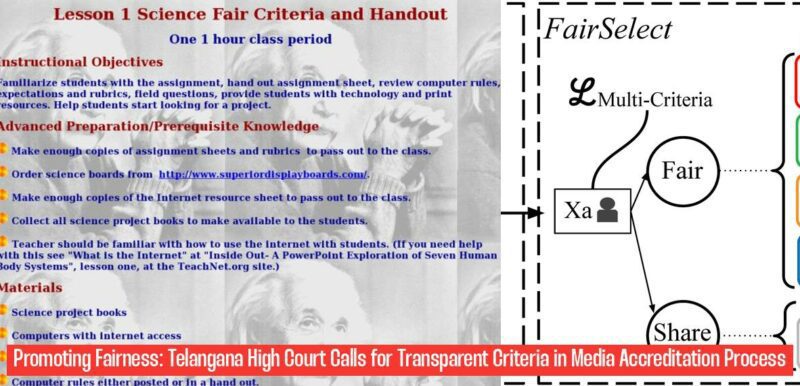Justice League: Telangana High Court Champions Fair Criteria for Media Accreditation
In a landmark ruling that underscores the importance of a level playing field for journalists, the Telangana High Court has directed the state government to adopt fair, rational, and reasonable criteria for granting media accreditation. This decision comes as a welcome breath of fresh air, particularly in a media landscape increasingly marked by the influence of language and regional biases. The court has unequivocally stated that media accreditation should not be contingent on the language of publication, ensuring that all journalists, regardless of their linguistic background, have equal opportunities to access information and report on events.
The High Court’s directive stems from a petition challenging the validity of G.O.Ms.No.239, a government order that had previously governed media accreditation in the state. The petitioners argued that the criteria used for accreditation were discriminatory and favored certain publications over others, effectively creating an uneven playing field. The court, recognizing the merits of this argument, has now mandated the implementation of fair and equitable criteria that do not discriminate based on language.
This decision is a significant victory for media freedom and a crucial step towards ensuring an inclusive and representative media landscape. It acknowledges the vital role that journalists play in a democratic society and emphasizes the need for a transparent and impartial accreditation process. The court’s ruling sends a strong message that media accreditation should be based on merit, professionalism, and adherence to ethical journalistic standards, rather than linguistic affiliations.
The High Court’s directive is a timely reminder of the need for a robust and fair system for media accreditation. It underscores the importance of ensuring that journalists from all backgrounds have equal access to information and the opportunity to contribute to public discourse. This decision sets a precedent for other states to follow, moving towards a more equitable and inclusive media landscape in India.
Beyond Language: The Need for Transparent and Objective Criteria
The High Court’s ruling goes beyond simply addressing the issue of language bias. It highlights the broader need for a transparent and objective system for media accreditation. The court has recognized that the existing criteria, often subjective and open to interpretation, can lead to arbitrariness and discrimination. This can result in the exclusion of deserving journalists and the granting of accreditation to those who may not meet the required standards.
The court’s emphasis on fair and reasonable criteria underscores the need for a standardized system that is based on clear and objective parameters. These parameters could include factors such as:
- Professional experience: Journalists should have a demonstrable track record of professional journalism, covering diverse topics and events.
- Journalistic ethics: A commitment to adhering to ethical standards of journalism, including accuracy, objectivity, and fairness.
- Education and training: Demonstrating a solid foundation in journalism through formal education or relevant training programs.
- Accreditation from recognized bodies: Membership in professional journalism associations or having received accreditation from credible journalistic organizations.
- Contributions to public discourse: Demonstrating significant contributions to public understanding and engagement through investigative reporting, in-depth analysis, or impactful stories.
By implementing such objective criteria, the accreditation process can be made more transparent, accountable, and less susceptible to bias. This will ensure that media accreditation is awarded based on merit, fostering a more diverse and representative media landscape.
The Power of the Press: Ensuring an Informed and Engaged Public
The media plays a vital role in a democratic society. It acts as a watchdog, holding those in power accountable, informing the public, and fostering critical thinking and debate. A free and independent press is essential for ensuring transparency, accountability, and public participation in decision-making processes.
However, for the media to fulfill this crucial role effectively, it needs to be representative and inclusive. This means ensuring that journalists from diverse backgrounds, languages, and perspectives have equal opportunities to access information and report on events. The Telangana High Court’s decision is a significant step in this direction, recognizing the importance of a diverse and inclusive media landscape in promoting an informed and engaged public.
The court’s ruling is a powerful message to all stakeholders involved in the media industry – from government officials to media houses and journalists themselves. It underscores the need for a fair and transparent system that upholds the principles of media freedom and promotes an inclusive and representative media landscape. By ensuring that all journalists have equal opportunities to contribute to public discourse, we can create a more informed and engaged society, one that is better equipped to make informed decisions and hold those in power accountable.
A Call for Action: Building a More Inclusive Media Landscape
The Telangana High Court’s decision is a positive step towards a more inclusive and representative media landscape. However, it is essential to recognize that this is just the beginning. The challenge now lies in implementing these fair and reasonable criteria in a way that ensures transparency and accountability.
Here are some steps that can be taken to build a more inclusive media landscape:
- Developing a standardized framework for media accreditation: The government should work with stakeholders, including journalists, media organizations, and experts, to develop a standardized framework for media accreditation that is based on clear and objective criteria. This framework should be transparent and publicly available, ensuring that all stakeholders are aware of the criteria and the process.
- Establishing an independent accreditation body: To ensure impartiality and transparency, an independent accreditation body should be set up, free from political interference. This body would be responsible for overseeing the accreditation process, ensuring that it is conducted fairly and in accordance with the established criteria.
- Promoting diversity and inclusion in journalism: Media houses and organizations should actively promote diversity and inclusion in their hiring practices, ensuring that journalists from all backgrounds, languages, and perspectives are represented. This will contribute to a more balanced and representative media landscape.
- Encouraging media literacy among the public: It is crucial to educate the public about media literacy, helping them to critically evaluate information and identify biases. This will enable citizens to make informed decisions and hold the media accountable.
By taking these steps, we can create a more inclusive and representative media landscape, one that truly reflects the diversity of our society and empowers all citizens to participate in public discourse.
A Legacy of Justice: Ensuring a Fair and Equitable Media Landscape
The Telangana High Court’s decision is a testament to the power of the judiciary in upholding fundamental rights and ensuring a fair and equitable media landscape. It is a reminder that the media, as a vital pillar of democracy, must be free from undue influence and discrimination, allowing all journalists to contribute to public discourse and hold those in power accountable.
This ruling sets a precedent for other states to follow, paving the way for a more inclusive and representative media landscape across India. By adopting fair and reasonable criteria for media accreditation, we can ensure that all journalists have equal opportunities to access information and report on events, ultimately contributing to a more informed and engaged citizenry. The legacy of justice, as championed by the Telangana High Court, is one that should be embraced by all stakeholders, working together to create a media landscape that is fair, equitable, and truly representative of the diverse voices of our nation.
What prompted the Telangana High Court to issue a directive regarding media accreditation?
The Telangana High Court issued a directive regarding media accreditation to ensure fair, rational, and reasonable criteria are adopted by the state government.
Why did the High Court emphasize that media accreditation should not be based on language?
The High Court emphasized that media accreditation should not be based on language to provide equal opportunities for journalists of all linguistic backgrounds to access information and report on events.
What was the basis of the petition challenging the validity of G.O.Ms.No.239?
The petition challenging the validity of G.O.Ms.No.239 argued that the criteria used for media accreditation were discriminatory and favored certain publications, creating an uneven playing field.
What broader aspect does the High Court’s ruling on media accreditation address beyond language bias?
Besides language bias, the High Court’s ruling addresses the need for a transparent and objective system for media accreditation, emphasizing the importance of merit, professionalism, and adherence to ethical journalistic standards.



